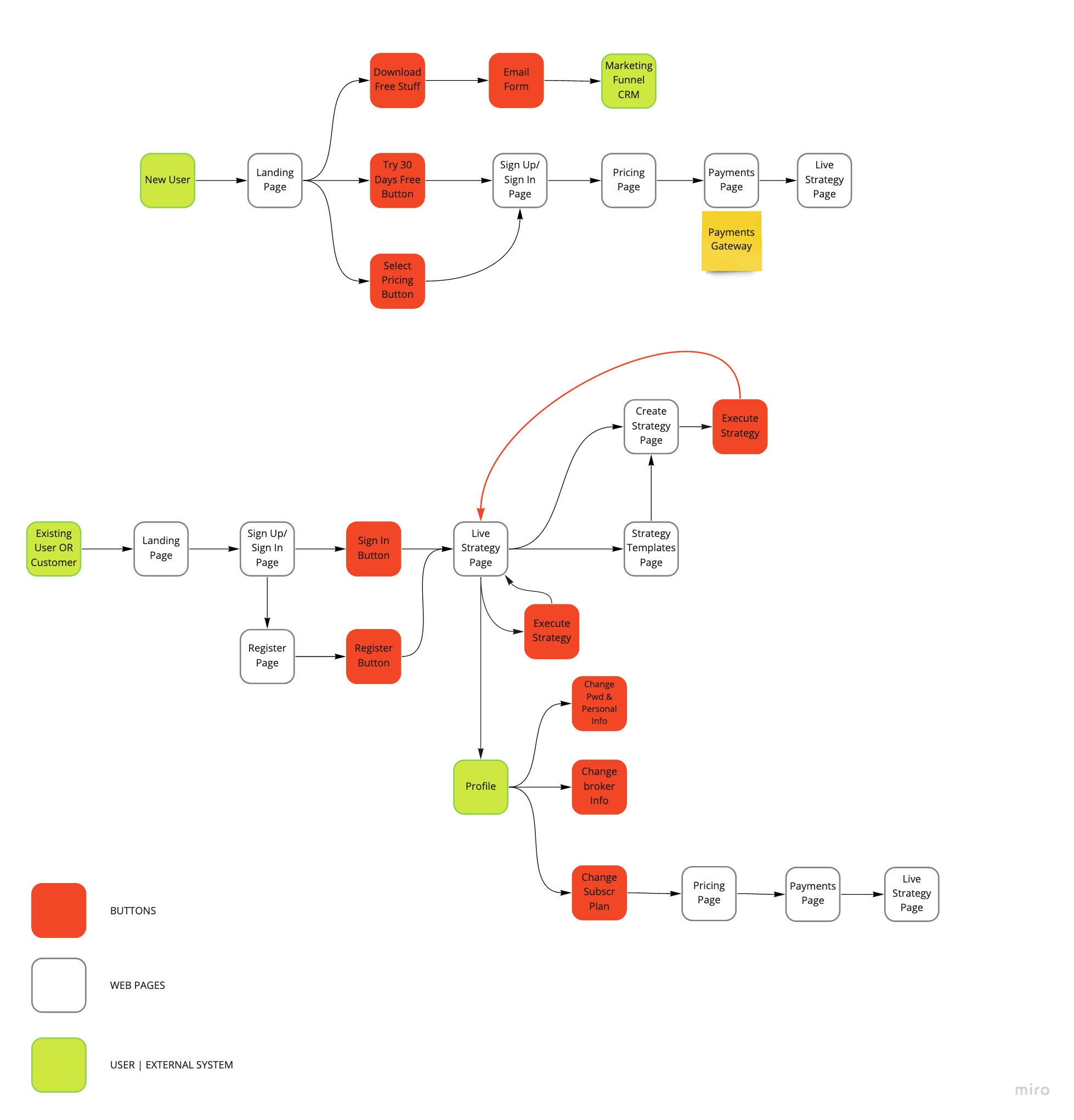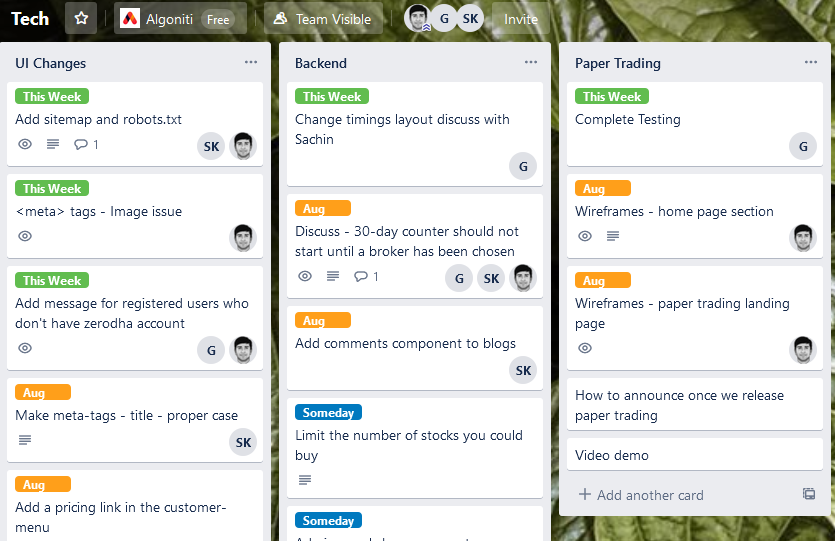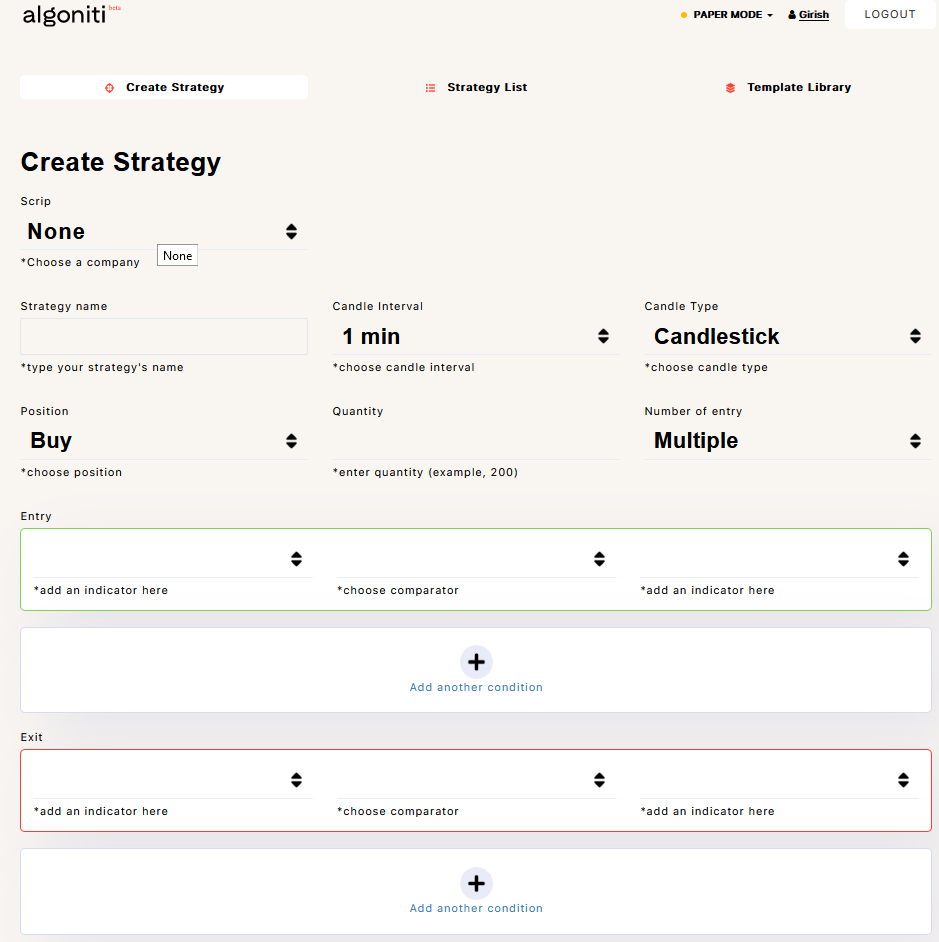
📜 Background and Motivation
In 2019, a few months before the COVID pandemic hit, I was hankering to put my tech and product skills to test. Having spent a little over a decade in tech, with over 6 in product, I wanted to prove to myself that I could build a company from the ground-up and scale it. A longtime friend and entrepreneur from India came to me with an offer and I jumped with both feet, building Algoniti, a FinTech platform for the Indian markets.
Algoniti is a SaaS platform for no-code, indicator-based strategy creation and execution. It lets you build a trading strategy and execute it through your broker. Your strategy executes automatically as the conditions in your program are met, freeing you from having to monitor the stock prices manually.
Value Proposition
Currently (as of 2020), there are very few products in the Indian retail financial space which let traders build their own trading strategies; most of them require traders to code their strategy using a programming language, limiting access for people who can’t code. This is a need I decided to address: simplifying strategy creation so people who don’t know coding could build strategies and execute trades.
📹 Initial Research
Before building the product I wanted to check the competition, and market viability: appetite among my target users, is the need big enough that they would be willing to pay for a solution, etc.
Market Research
I collected info on the total market size, brokers offering algo-trading as a service, and estimated the number of interested users. The algo-trading market is estimated to grow 20% yearly between 2020 and 2025.
Next I did some competitive analysis and found the alternatives lacking in a good tech solution which users could automate effortlessly. This bolstered our hypothesis about lack of a good solution.
Checking Product Viability
To check the market appetite I and my partner decided to get a few data points. We wrote an article about algo-trading - its benefits, how-tos, constraints. Within a week we received over 500 user visits, and the article started being promoted as a suggested search results on Google Search. This confirmed that there was a high demand, and a corresponding lack of information about this space in our market.
Next we created a Facebook advertisement for early-access signup for our platform. We received over 280 signups on the advertisement, indicating that people were interested and might pay if we built a good product.
⌛ Product Strategy, Pricing, Go To Market
Competitive research and viability analysis helped me define a product vision (growth plan, focus area, MVP features) and target user persona. For sales I chose a monthly subscription-based SaaS model based on the long term plans for product growth. This model is considered relatively low-risk by our target customers as they could cancel anytime. I also started offering a one month trial to help drive customers through my sales funnel.
Being a bootstrapped startup we didn’t have a lot of money to throw on paid advertising. I decided to focus on content marketing and SEO. I built an email marketing campaign to turn warm by providing good- quality, information-heavy content.
🥷 Building a Team
Dev
My cofounder redirected 2 software developers from his other projects towards building the platform, with me leading the product development and a few other areas. Soon the dev team grew to 3 when I hired a web-designer.
Marketing
Marketing was an area I learnt the most about. Before I started on the entrepreneurship journey I knew precious little about marketing. coming from a primarily software dev background.
One of the biggest takeaways was about the difference in marketing strategies in the United States and in India. The Indian market relies more heavily on word-of-mouth marketing than ratings/reviews/rankings. We also see a relatively low search engine volume in India, even for high-usage products, primarily because people rely on information they get from friends and acquaintances, compared to a search engine. I think this is a function of a relatively low-penetration of internet in my target-market in India (not talking about Instagram here).
This led me to focus more on content marketing, referrals, and relationship marketing as compared to SEO and buying ad-words. I did consult with an SEO consultant for some basic website optimization, but mostly focused on content.
I hired a content writer to create blogs and maintain the company’s presence on social platforms like Facebook and Quora.
The idea was to build brand-image and trust by projecting Algoniti as an expert in the algo-trading field.
🔮 Building the MVP
Prioritizing Features
Algoniti provides a service by auto-generating and sending orders to a trader’s broker - so effectively, it sits between the trader and their broker. This means that integrating with multiple brokers was crucial for growth. For MVP I decided to integrate with a single broker which served the largest volume among my target users.
I’ve always been a proponent of using flows/diagrams to explain complex concepts. Below is an example user flow for the MVP.

Managing Project Timelines
I lead the project timelines for Marketing and Product development and used Trello for tracking. Here’s how the dev board looked like.

🚴♂️ Launching MVP, Tracking Metrics, KPIs..
I launched the platform in April, 2020 after 5 months of development. I user Google Analytics and HotJar to track visits and user experience. Three months since launch we have over 500 unique monthly visitors and over 100 customers.
The objective for the MVP launch was basically customer acquisition. I monitored the following metrics to keep track of the KPIs.
- Website visitors - Weekly and Monthly
- Free Users
- Subscribers
- Conversion Rate

🤼 Business Negotiation
Building Strategic Partnerships
I collected user feedback which helped uncover a major issue - a lot of my trial customers didn’t know much about algo-trading, and how it could help them. To resolve this I partnered with an educational institute which would train our customers on algo-trading. This helped us reduce our training costs, and gained us additional customers.
Pitching to VCs
I started pitching the product to VC firms after the product launch and received interest from 3 major firms in India. Unfortunately the pandemic situation prevented us to grow at a rate needed to get to the series-A, which I was planning within a year.
🚀 Looking Ahead
This was a fun experience and I learnt more in a year as an entrepreneur that in 6 years prior working as a product manager. Unfortunately, COVID hit a month after our launch, hampering my marketing plans which involved a great deal of travel. It also affected the user growth, hitting my initial fundraising efforts. I realized that not being in India was not helping the company, and stepped back giving the control to my partner.
It was a difficult decision - launching this company involved a lot of proverbial blood and sweat - but in hindsight it was a great learning experience. I’ve decided to take a break from entrepreneurship for a few years, but hope to be back at it sometime in the next few years.